NGINX vs Apache: A Performance Comparison
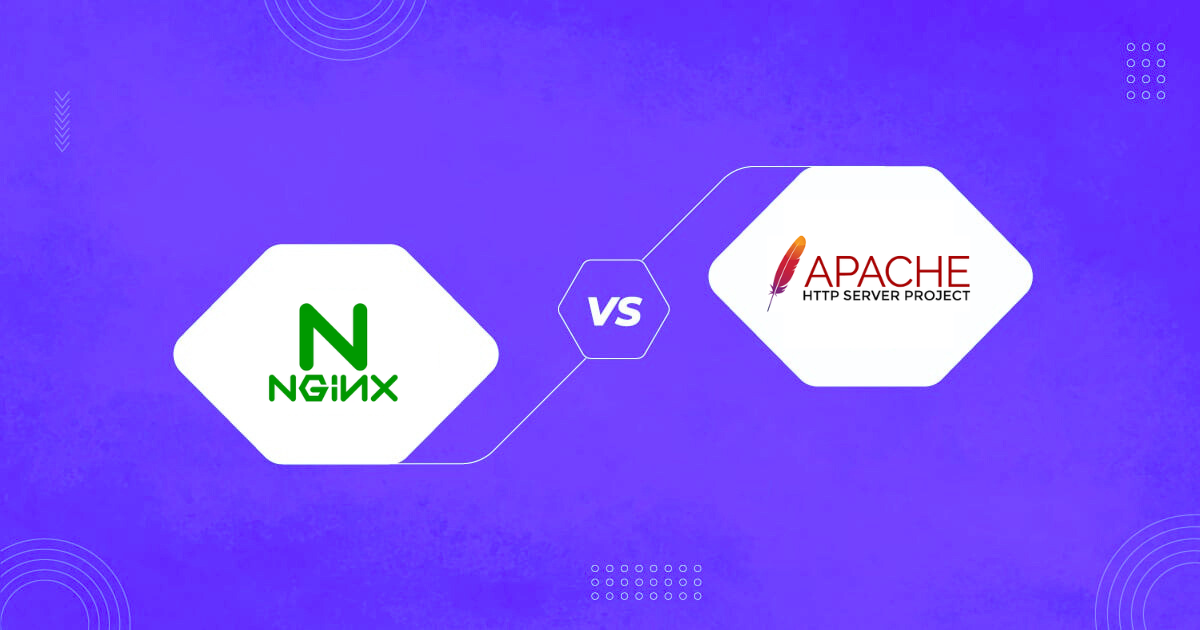
NGINX and Apache are the two most popular web servers in use today. They are both formidable open-source web servers that have served millions of websites worldwide. Depending on your needs, one or both can help you create a robust, scalable, and high-performance web application.
So which web server is the right one for your project? Whether you are a small businessperson and want to launch your very first Wordpress site or a seasoned developer who handles complex applications, knowing the strengths and differences between NGINX and Apache is crucial to optimizing your website's performance and scalability.
This post will review their key features and performance benchmarks and demonstrate how each performs under various scenarios. By the time you are done, you should understand which web server best suits your needs and be able to choose one confidently.
What is a Web Server?
The web server is the backbone of any website, but what does it do? Let me explain in straightforward terms. Go to your browser and type the address of a website. What happens next?
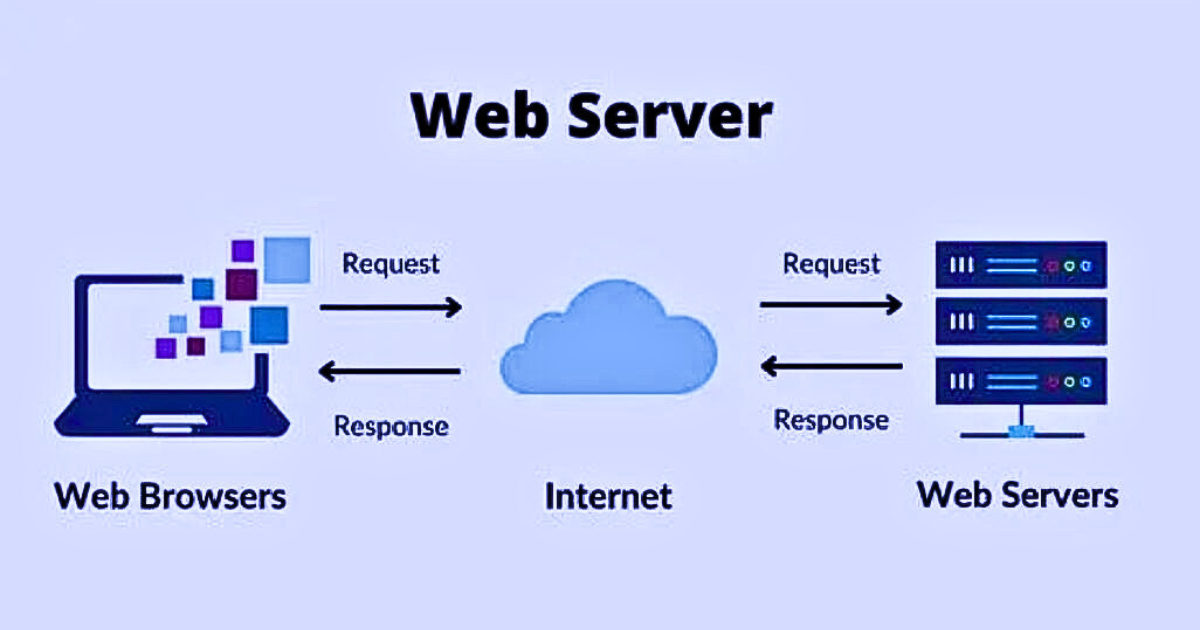
The request is forwarded through your browser to a web server. This web server is like the ultra-organized librarian who knows where everything is. The server interprets your web requests and is responsible for storing, processing, and delivering the web pages you are trying to access.
A web server is good at serving up web content directly, including HTML pages, images, videos, and more. It listens for multiple requests from the browser and then responds, sending back the appropriate content.
Without web servers, you couldn't access your favorite websites, because no system would be set up to deliver what you request.
Whether it's browsing blogs, shopping online, or even reading this article, a web server is at work behind the scenes to take client requests and ensure that things load smoothly.
NGINX vs. Apache: An Overview
The decision between NGINX and Apache can feel like choosing between the two heavyweights within the web server world. Each is right for different configurations. Let's break it down so you can feel more confident about your decision.
Apache: the Flexible Veteran
Apache, also known as Apache HTTP Server, has built a reputation as one of the most reliable web servers since the 1990s. It is also flexible and readily customizable.
The Apache web server uses a process-driven model, treating every request as a separate process. That makes it a good fit for smaller sites or those unlikely to experience sudden heavy traffic spikes.
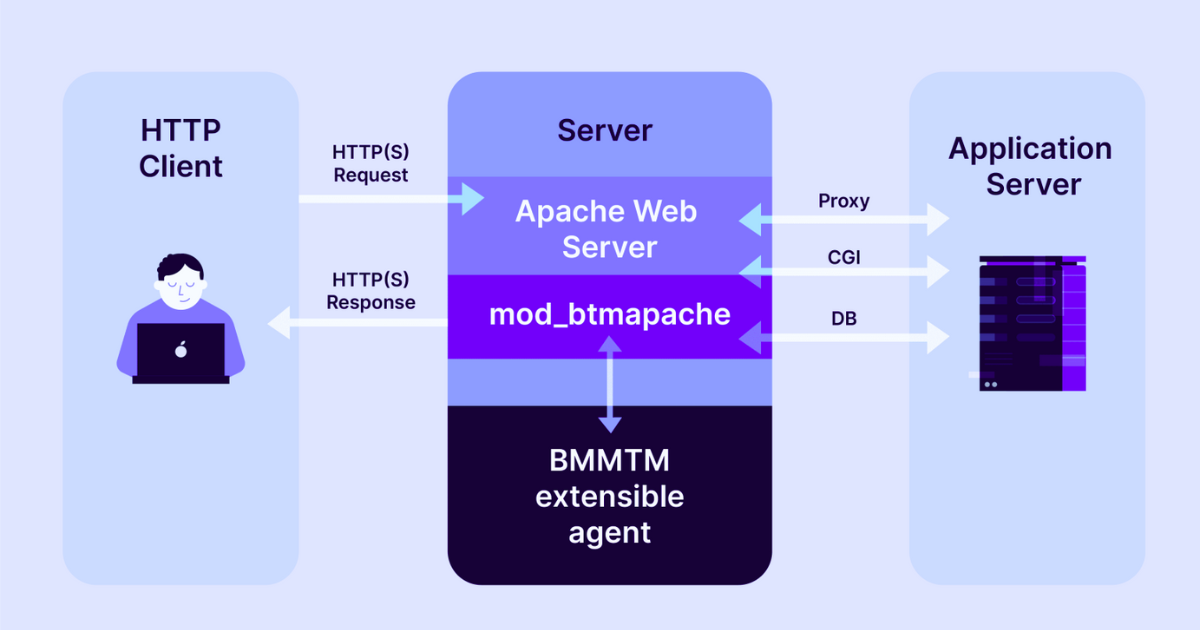
The biggest strengths include its modular design, which allows users to add or remove features through modules, such as SSL support or URL rewriting. This makes Apache a go-to choice for developers who want control and customization.
Apache integrates well with various operating systems and can easily handle static files and dynamic content, making it ideal for more complex websites.
NGINX: Performance Powerhouse
NGINX, pronounced "Engine-X," was designed to handle modern web traffic. Its event-driven, asynchronous architecture can support thousands of connections concurrently without over-consuming system resources.
For this reason, NGINX is extremely popular among high-traffic websites, content-heavy platforms, and enterprises where performance matters. It's particularly good at serving client requests for static files fast, like images or HTML, which makes it very well-suited for sites needing to handle massive volumes of media.

It can also act as a reverse proxy server, excelling at balancing loads and distributing traffic across several servers. While it may not be as customizable as Apache, its design's focus on speed and stability makes it one of the top choices for anyone running high-demand sites or applications in which performance is a factor.
Both of these servers have pros and cons. The key to choosing the correct server is to know what you need: performance, flexibility, or ease of use—it's all about what best fits your project!
Advantages and Disadvantages of NGINX
The lightweight architecture, efficient resource utilization, and exceptional scalability of NGINX make it ideal for handling high-traffic websites and demanding applications. This popular web server is also known for its reliability and fault tolerance, ensuring minimal downtime and continuous service. However, while NGINX excels in certain areas, it does also have limitations compared to other web servers.
Advantages
Speed and Efficiency: If you are after performance, look no farther. Thanks to its event-driven architecture, NGINX comfortably serves several thousand concurrent connections out of the box. So it's perfect for a site that regularly handles high-traffic loads.
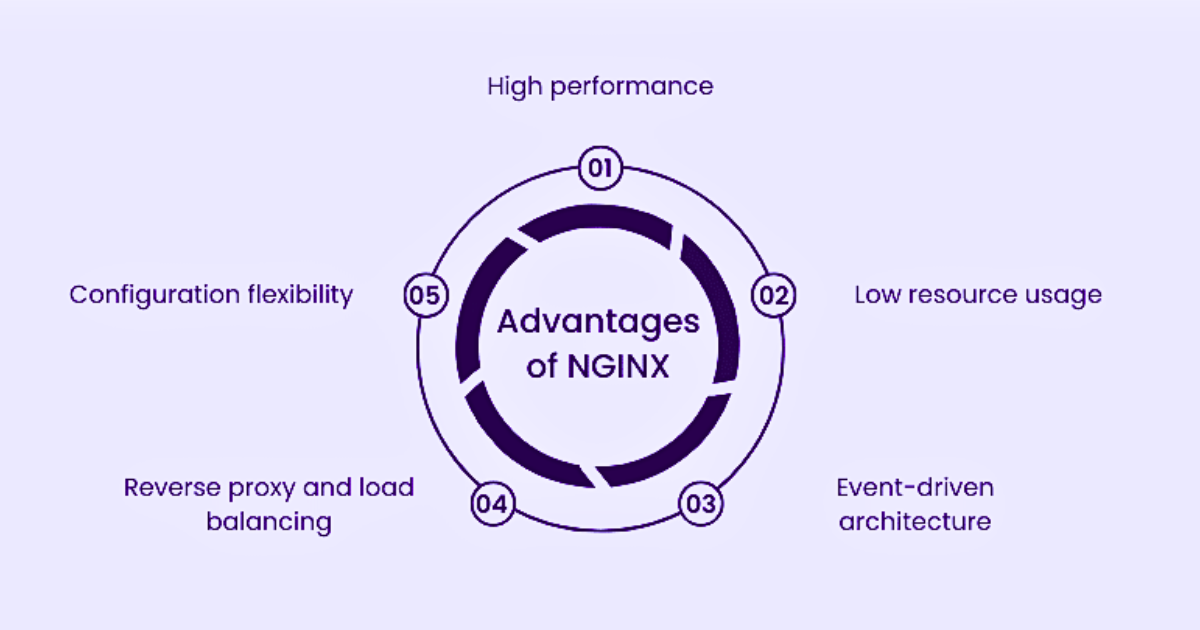
Low Resource Consumption: NGINX, unlike Apache, is lean and mean, making it perfect for servers with limited hardware or where resource efficiency matters.
Load Balancing: NGINX performs impressively as a load balancer for several servers. It spreads client requests across your system considerably easily, keeping things quick.
Security: NGINX offers security features such as to restrict access to certain parts of your site and DDoS protection.
Disadvantages
Less Customizable: Though NGINX is faster, it is not as flexible as Apache with the module system and customization. You might find the options to configure NGINX a bit limiting if you love tweaking the nitty-gritty details.
Steep Learning Curve: NGINX configuration files are very different from Apache, and to anyone not used to them, they may feel slightly less intuitive. It has a bit of a learning curve, especially if you have gotten used to Apache.
Poor support for .htaccess: NGINX doesn't natively support .htaccess files, which can be a significant drawback if you come from an Apache environment. You'd still need to go into the configuration files directly for similar functionality.
Pros and Cons of Apache
Now, let's review some of Apache's pros and cons to determine whether it is the right match for your needs.
Advantages of Apache:
Highly Customizable: Apache's flexibility is why many NGINX users defect. If you love to tinker with settings, add features, and otherwise fine-tune your web server, Apache's modular system will be a dream come true. You can enable or disable various modules to get the necessary functionality.
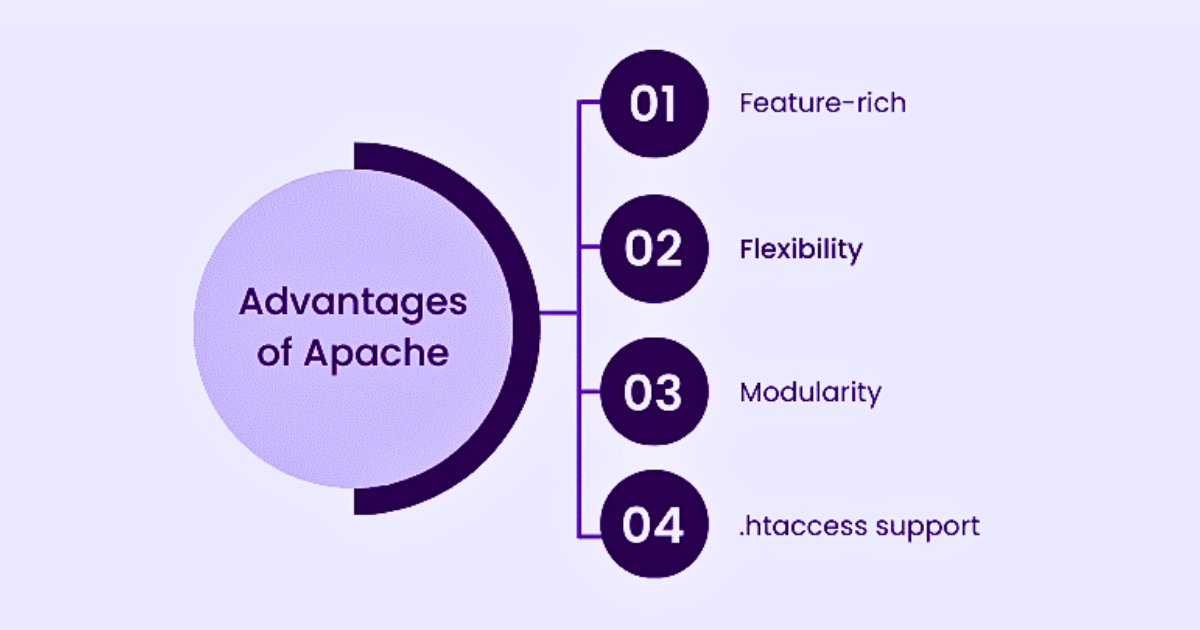
Extensive Documentation and Widespread Usage: Apache has been around for years, with vast documentation and a large number of users. If you're having an issue, then someone else probably encountered and solved it long ago. Help is just one search away.
Apache's .htaccess: Apache's .htaccess supportis huge for many website owners. With Apache, you get per-directory rules through .htaccess, making it flexible to configure a particular directory without changing the main configuration file or big server configuration. Super handy!
Disadvantages of Using Apache
Heavy traffic: While Apache is ready to go with smaller or moderately trafficked sites, it tends to slow down at very high numbers of simultaneous requests. Its process-driven model uses more resources, making it less efficient than NGINX during extreme loads.
Resource-intensive:Apache's process-based approach uses more CPU and memory than servers like NGINX. If you are running a resource-constrained server,this might be a disadvantage.
Serving speed: Apache is not as efficient as NGINX at delivering static content, such as images and HTML. If your site depends on heavy content management systems, Apache might get a bit slow for you.
NGINX vs Apache Web Servers: An Extensive Comparison
Both Apache and NGINX are considered industry leaders, but each operating systems has strengths and weaknesses, making it suitable for different use scenarios. Let's break down the comparison to help you find what works for your needs.
1. Performance: Speed and Resource Handling
The most important difference in performance between NGINX and Apache is how each handles connections.
Apache: Apache is a process-driven model, meaning each connection gets a new process or thread. It can handle a good amount of traffic; however, server resources are consumed rapidly as concurrent connections increase. High-traffic websites can greatly slow down when trying to process dynamic content natively.
NGINX: The NGINX web server follows an event-driven architecture. It can serve thousands of concurrent connections with a minimal amount of memory, making it ideal for high-traffic sites where speed and efficiency are crucial. It scores top performance grades, especially in serving static content.
NGINX is probably the better option if you anticipate a high traffic volume or would like to squeeze every bit of throughput out of your server arrangement. If you are running a small site or don't mind tweaking configurations for specific workloads, Apache still has much to offer.
2. Easy to Configure
How comfortable are you with custom configurations? This could be the deciding factor.
Apache: Apache is highly configurable. It also supports overriding the directory level configuration with .htaccess files. Moreover, non-privileged users can control specific website elements without taking control of the full configuration file.
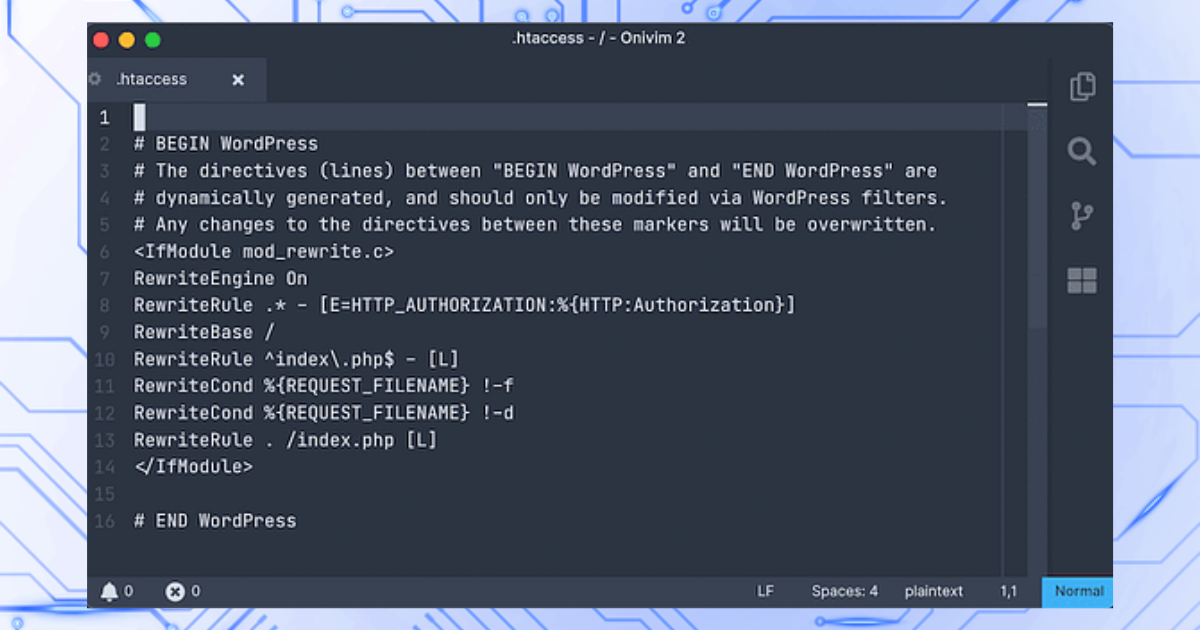
That means you can allow users to have some control without giving access to the directory level configuration. That is a big advantage when working with multiple servers on shared hosting providers or maintaining different site owners on the same server.
NGINX: NGINX does not support .htaccess files. Configuration is somewhat centralized to a single configuration file. This can be efficient and reduce overhead, but it means all configuration modifications must be done by an admin. If one has to manage several users or sites, this would be a disadvantage.
If simplicity and central control are more your speed, then NGINX may be your best option; however, if granular per-directory control with user flexibility is needed or wanted, then Apache's configuration style may be appropriate.
3. Managing Dynamic Content
Both NGINX and Apache can serve static content quite well. Still, when it comes to dynamic content, the content generated on the web server using PHP execution or another approach differs.
Apache: Apache's strengths lie in its tight integration with scripting languages. It can handle many PHP files with a Apache module called mod_php, whereby PHP runs as part of the same process and is quite easy to use by many applications. This works effortlessly for small to medium-sized PHP applications.
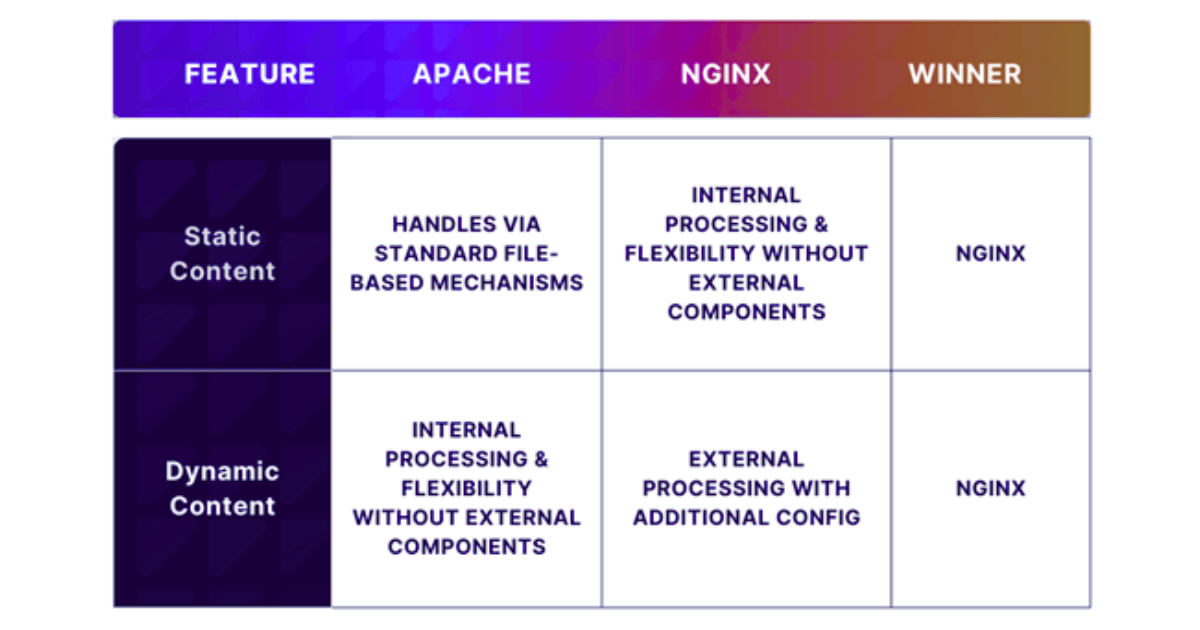
NGINX: By contrast, NGINX does not process dynamic content itself. Instead, it is configured to use an external processor capable of routing dynamic requests to another server, usually PHP-FPM or another backend. It may look like extra overhead, but for more significant sites, this is an advantage, because NGINX can offload static content. At the same time, PHP-FPM efficiently can handle dynamic content internally.
If you're working on a small or simple PHP application, Apache's built-in support is a convenient option. However, for bigger, more complex applications with great traffic, NGINX uses a proxy model that seems to perform better with PHP-FPM.
4. Security Features
Security is always a concern, no matter the size of your project. So, how do Apache and NGINX fare on this count?
Apache: Apache is designed on a modular architecture, which, while providing flexibility, often proves to contain security vulnerabilities when the module system is not updated. It does provide some security features at a user level, like the .htaccess files, which come in handy.
NGINX:The event-driven model of NGINX alone ensures that many vulnerabilities that arise from handling multiple processes are minimized. Its simpler codebase and single configuration also reduce the attack surface. NGINX is often considered more secure because it doesn't allow user-specific configuration using .htaccess. This reduces risks from misconfigurations in each worker instance.
If you're looking for a server that is secure out of the box with fewer chances of misconfiguration, NGINX is the safer bet. But Apache can also be entirely secure with the correct setup and monitoring.
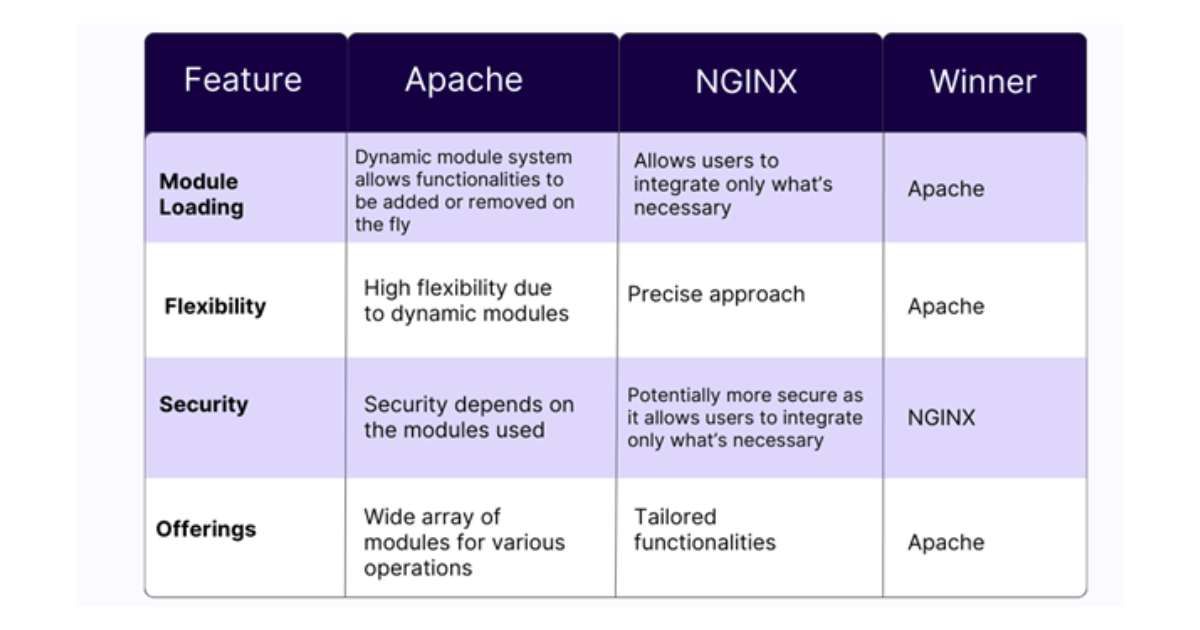
5. Flexibility and Modules
NGINX and Apache are modular, enabling them to extend their functionality using external components and dynamic modules through different plugins. However, they approach this differently.
Apache: Apache has a huge number of dynamically loadable modules, which means you can load and unload depending on what you need, from handling proxy connections to enabling custom logging. This can be very powerful if you use a web application firewall with many custom features.
NGINX: NGINX also supports the module system, but must be compiled into the server at build time. You cannot simply add a module in flight like with Apache. That said, the NGINX module ecosystem is growing rapidly and most users find it provides all the functionality necessary out of the box.
Want to have complete flexibility over adding arbitrary features without restarting the server? Apache's module approach is better. Want a leaner, fewer-moving-parts server? Then NGINX will do the job.
6. Community Support and Ecosystem
Another aspect you might want to consider is the community support and ecosystem around those web servers.
Apache server: One of the oldest web servers, Apache has an enormous, active community, extensive documentation, and a well-oiled ecosystem. When working with an Apache server, you will probably find many tutorials, forums, and support that make debugging easier.
NGINX: Although NGINX is younger, its popularity has created a great community and very good documentation. There is also an NGINX Plus version dedicated to enterprise users, which includes additional support and features for those who need them.
Both servers have enjoyed excellent community support; however, the Apache ecosystem has existed longer, which might have advantages in both community support and finding more resources and examples. However, NGINX is catching up pretty fast and is robustly supported.
Choosing the Best Web Server
With so many options available, choosing the right web server for your project can make your head spin. Which one dominates the web server field? And which one will suit you best?
If you're running a smaller website or just getting started, Apache may be the easier choice. It has been around for a while, and with its inbuilt flexibility—for example, being able to make configuration settings and configure with .htaccess files—allows some changes to be made without needing full admin access. Also, it's compatible with dynamic content, especially if you are using PHP, so getting started is relatively easy.
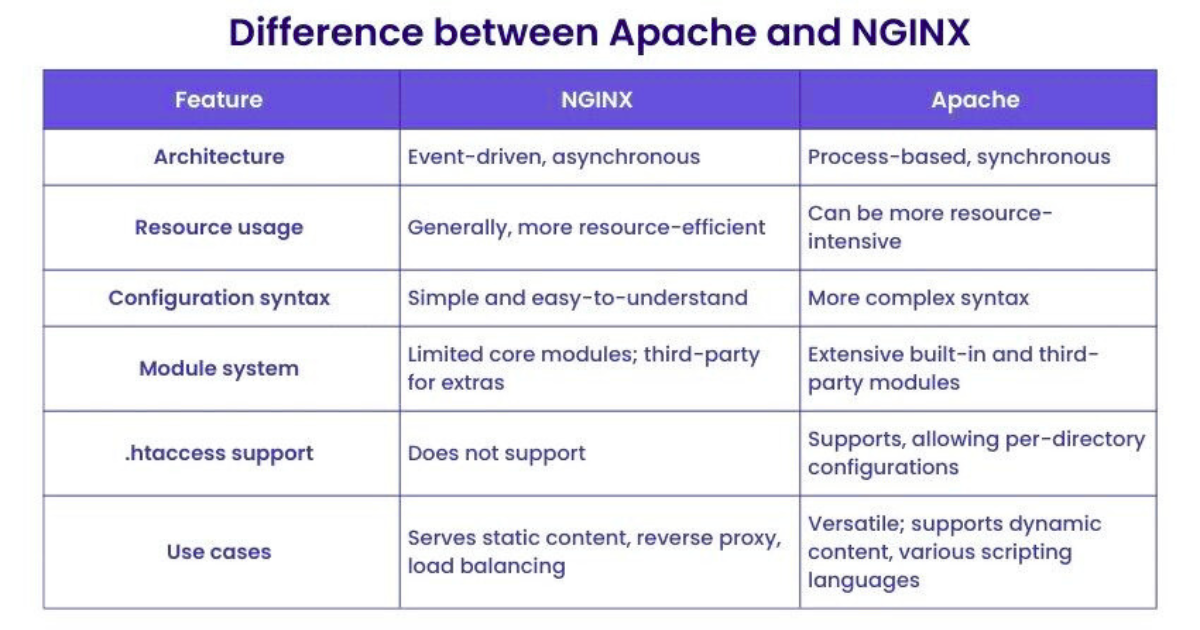
But if you want to build something that churns a lot of traffic or are into efficiency and performance in general, maybe you should look at NGINX. It shines when serving static content quickly and handling many concurrent connections at minimal resource consumption.
You'll notice the difference in speed, especially when your site grows, or you're dealing with multiple requests from many users simultaneously. NGINX's approach might be slightly less flexible, especially without support for .htaccess, but it works amazingly for people who want something lean and fast.
Ultimately, it all depends on the type of website you will be hosting and your ultimate goal for that site. If usability and flexibility are necessary to your project, then Apache is probably the better choice.
But if your priorities are primarily scalability and performance, you'll find NGINX better suited to your needs. Whichever way you lean, both servers are rock solid and a great choice.
NGINX as a Reverse Proxy Server
NGINX can be used as a reverse proxy server, which is useful in terms of performance tinkering, security enhancements, or load scaling. This means NGINX sits between your users and your backend servers, routing incoming requests to various servers and returning responses to the client without the client knowing what's happening in the background.
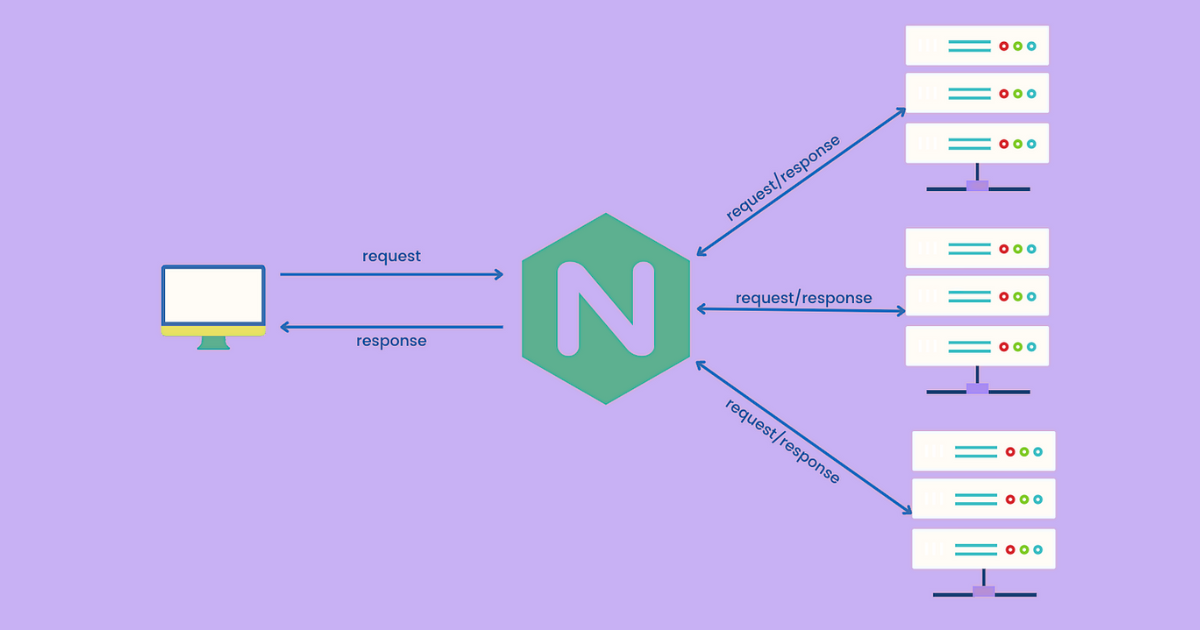
It lets you run several applications or websites from a single server efficiently and boosts load times by caching static content. And let's not forget about security: by keeping your backend servers hidden behind NGINX, you reduce the risk of direct attacks.
It is also relatively easy to set up. You define the upstream servers and instruct NGINX where to pass requests. Once set up, you will notice a difference in smoothness, mainly if you deal with high traffic.
And if you're anything like the average developer, that increase in productivity will keep many headaches at bay—seriously invested in perfecting your web infrastructure? It pays to take the time to try NGINX as a reverse proxy.
VPSServer with NGINX and Apache
Regarding VPS hosting with VPSServer, both Nginx and Apache play crucial roles in web server management. Apache, known for its flexibility and compatibility, works seamlessly with VPS environments, offering rich support for .htaccess files and a wide range of modules to customize performance.
On the other hand, Nginx shines with its lightweight and efficient architecture, making it ideal for handling high traffic on a VPS with optimal server performance and minimal resource consumption. With VPSServer's robust infrastructure, you can leverage either server—whether you prioritize Apache’s extensive feature set or Nginx’s speed and scalability—to optimize your website's performance.
Conclusion
In the end, Apache and NGINX have strengths and weaknesses that correspond to one or another type of web hosting demand. While Apache excels in flexibility, compatibility, and ease of use with dynamic content, Nginx is far more performant regarding high loads, scalability, and resource efficiency, especially for websites with extra-high traffic.
This greatly depends on what your website needs. However, either way, with a VPS hosting service like VPSServer, you can employ the powers of either server for optimal performance, security, and reliability of your online presence.
Frequently Asked Questions
Is it possible to use both Apache and NGINX together on the same server?
Yes, many developers use NGINX as a reverse proxy in front of Apache. In such an environment, NGINX forwards incoming requests to Apache and combines the powers of both servers.
Is it possible to use both Apache and NGINX together on the same server?
Yes, many developers use NGINX as a reverse proxy in front of Apache. In such an environment, NGINX forwards incoming requests to Apache and combines the powers of both servers.
What are some of the capabilities regarding logging and monitoring for both Apache and NGINX?
Both servers can log, although the Apache logging format is more flexible and can be easily tailored to your needs. On the other hand, NGINX logs are high-performance; if necessary, they can be combined with monitoring tools such as Kibana or Grafana.
What is the key difference between static and dynamic content?
The difference between static and dynamic content is that static content does not differ from consumer to consumer because it is prebuilt. It could be in the form of HTML, images, or something else. Dynamic is created on the fly when requested by the person interacting with the application or website, and needs some processing on the server side by executing database queries, scripting, etc.
How do multi-processing modules determine Apache's performance, and is there any way third-party modules can modify it?
MPMs are a class of modules within Apache that dictate performance based upon the method in which requests are handled-process-based or thread-based. Third-party modules can affect this further by adding functionality that may impact resource use and could optimize, or otherwise degrade, the overall performance depending on their design and configuration.
Which is better for API management, NGINX or Apollo?
Apollo is more friendly for GraphQL API management due to the presence of specific tools for schema design, query optimization, and state management. NGINX is better for routing and managing traffic but lacks API-specific features.











